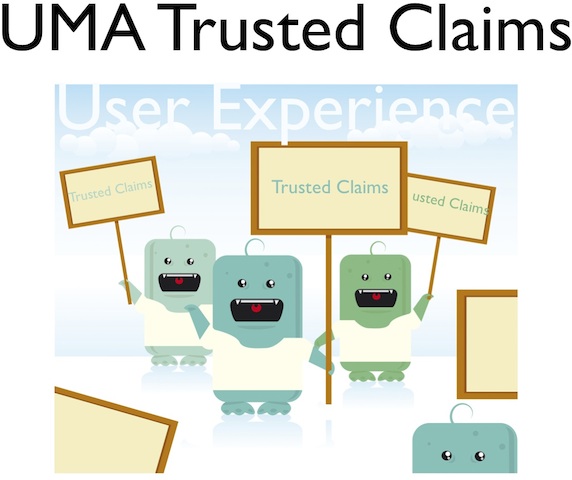This page collects wireframes (mockup screenshots, to varying degrees of detail) that show how human beings might experience interactions with devices and software services that implement parts of the User-Managed Access (UMA) proposition.
Domenico Catalano is the UMA group's Graphics/UX Editor. We will add more wireframes and other user experience resources here as they are created.
SMART Project Implementation
NOTE: As of July 2010, the SMART project is conducting a UX research study. See the flyer for details on how you can participate.
This page is dedicated to showing sample SMART project screenshots; check the SMART project blog for current versions and other project status.
Python Prototype
Christian Scholz's Python prototype has generated these screens:
- Getting started at a host
- AM interface
- Forcing a (human) requesting party to self-assert a label for themselves
Simplified CV Scenario
This set of wireframes was originally developed for the UMA webinar held on 29 Jan 2010 to map protocol details to user experience realities. The webinar overview slides explain the scenario setup and how often the various interactions are performed (most are one-time-only setup; the rest are optional).
Click the image to see the wireframes. (There are "click-throughs" on the screens to give you a simulated user experience; the instructions on the right-hand side indicate where most of the links are.)
Setting Policies and Terms
This is a single screen that was developed early in the ProtectServe/UMA process to explore policies and negotiation terms that might be interesting to an authorizing user. It is discussed further in the Issues section of the Scenarios and Use Cases document.
Real-Time Consent Gathered Out-of-Band
If some sort of "ask me for consent" option is presented to a user as shown in the above sections, in many cases the consent will need to be gathered in an out-of-band fashion. Mobile devices are popular for such a purpose. This set of wireframes was developed to explore how consent might be gathered from an authorizing user given that a requester has approached a host at a time when the user is not logged in to either of them. (Some reasons for needing real-time consent are discussed in the Requester Identification section of the Scenarios and Use Cases document.)
Click the image to see the wireframes.
Access Analytics
The benefit of being able to forge data-sharing relationships with others would be blunted if the authorizing user didn't have the opportunity to review the details of resource access after the fact. This set of wireframes was developed to explore the kinds of resource-access analytics a user might want to review, partly to manage sharing at the right level and partly as a tool for assessing privacy risk.
Click the image to see the wireframes.
UMA Trusted Claims
The UMA protocol supports the policy-driven ability of an AM to demand claims from a requesting party before authorization is granted. The claims may be self- asserted or third-party-asserted. This set of wireframes was developed to explore a person-to-person data sharing scenario in which the Authorizing User wants to restrict sharing to a specific Requesting Party identity. For such a policy to be meaningful it requires the AM to establish of trust of third- party identity claim issuers. The Wireframe includes the subject registration and the Claims Host registration as part of bootstrapping trust process.

